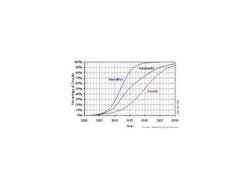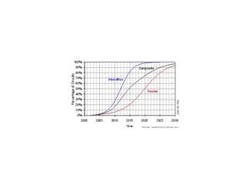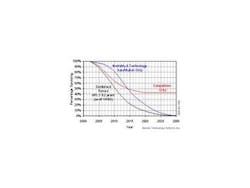24 June 2003 Austin, TX Lightwave-- Today's embedded standard singlemode fiber cables are already obsolete for high density, long-haul applications and may also become so in the local exchange, according to a new study by Technology Futures Inc., (TFI).
"When fiber was introduced into the local exchange in the early 1980s, we had little on which to base depreciation lives," says Ray Hodges, senior consultant at TFI, and co-author of the report. "We now have experience regarding the physical mortality of fiber as well as experience with singlemode fiber replacing multimode fiber."
He adds, "There are now advanced types of fiber capable of displacing the embedded singlemode as well as competitive issues that must be considered in the depreciation life estimation."
Presently, there is very little fiber in the distribution plant. The timing of placing distribution is late enough that, in all likelihood, it will be advanced fiber, according to TFI research. With long-haul fiber already using advanced fiber and newly placed distribution fiber also being advanced fiber, a bottleneck will be created in the middle of the network that contains the most outdated singlemode fiber.
TFI forecasts that, by 2010, incumbent local-exchange carriers (ILECs) will provision one-third fewer access lines than today, and that, by 2015, less than half as many. Competition will strand large quantities of network equipment including fiber cables, reducing the economic life.
Even so, by 2020, approximately 95% of U.S. households will be online and almost all of these will be broadband users, according to TFI research.
Other key findings in the report include:
•Three types of advanced fibers available today offer significant advantages when CWDM or DWDM are used.
•TFI continues to recommend a projection life of 15 to 20 years for non-metallic cable.
The new report "Depreciation Lives of Fiber Optic Cables in the Local Exchange," authored by Ray L. Hodges, and Lawrence K. Vanston, Ph.D., TFI president, addresses the economic life of singlemode fiber-optic cable installed by ILECs in the local-exchange network. The depreciation lives of these cables are derived from analysis of demand, technology substitution, physical mortality, and competitive factors. The research was sponsored by the Telecommunications Technology Forecasting Group, a consortium of telephone companies comprised of Bell Canada, BellSouth Telecommunications, Qwest, SBC, Sprint, and Verizon.

